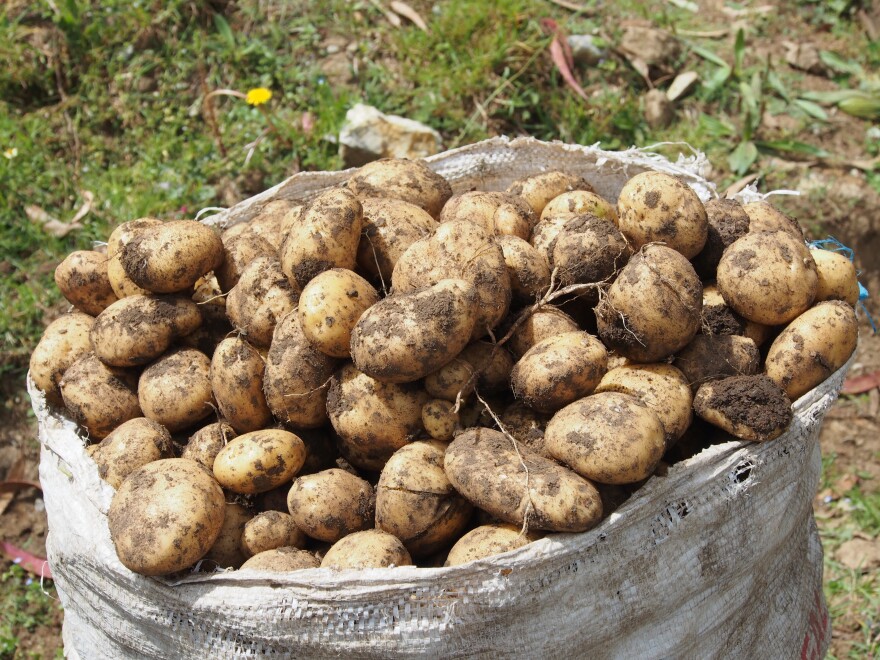The potato: mash, bake, and cook Regardless of how you look at it, the potato is the embodiment of everything commonplace.
However, there has long been a genetic enigma surrounding the domesticated potato and all of its wild relatives. According to Sandy Knapp, a botanist at the Natural History Museum in London, “we didn’t know where the whole potato lineage came from.”
Potatoes are most closely linked to two plant families, according to scientists: tomatoes and a group of three species known as Etuberosum. “They’re very cute,” Knapp remarks. “Their blossoms are purple. They are quite beautiful.
The problem was that some genes indicated that potatoes and tomatoes were more closely related, while other genes suggested that potatoes and Etuberosum were more closely connected. Which one was it? We were unable to create a family tree for these starchy vegetables and all of their cousins because of the uncertainty.
“That means there’s something funny going on,” Knapp responds. “When something doesn’t quite fall out right, that’s where the exciting biology is.”
Knapp and her colleagues propose in an article published in the journal Cell that the confusion resulted from an old interbreeding event between the ancestors of tomatoes and Etuberosum, which produced the potato lineage. Additionally, it happened at the ideal time for potatoes to occupy large areas of newly formed high-elevation habitat in the Andes.
The results, according to the researchers, should lead to the development of a better potato that could be bred with seeds to have advantageous qualities that could help them resist various obstacles, such as illness and climate change.
A lucky union
Knapp searches her kitchen and then displays a perfectly acceptable small potato. Her words, “These ones are really good boiled,”
“So all of the potatoes that we eat,” she adds, “the ones that are red, the ones that are little like this, the big ones, the ones we make into chips, all of those are one species we’ve domesticated that’s gone worldwide.”
There are currently 107 wild species in the Americas, where that species first appeared. Additionally, all of these potato plants have unique structures called subterranean tubers, which are the portion of the plant that we purchase, bake, and butter.
“They’re a way for a plant to store starch,” explains Knapp, “and, in a way, persist through seasons which are not good for growing.”
The confusing issue is that tubers are not seen in either tomatoes or Etuberosum, the closest cousins of potatoes.
Knapp and her team then set out to find the answers. Initially, scientists sequenced the genomes of many wild and domesticated potatoes, a few Etuberosum plants, and a few tomatoes. According to the experts, this is the most thorough examination of potato genomes ever carried out.
Remarkably, they discovered that potatoes possess a well-balanced combination of genes from Etuberosum and tomatoes. This implied that these two groups’ ancestors had hybridized a long time ago. In other words, they crossed to produce a new plant species that could grow tubers, something neither parent could do.
“That’s very important,” says Yiyuan Ding, a lead author of the paper and a Ph.D. candidate in bioinformatics at Huazhong Agricultural University, because it’s how the ancestor of current potatoes and an entire new plant lineage originated.
According to Knapp, “It’s a chance event,” This is the problem with evolution: sometimes it works and other times it doesn’t. And in this instance, we’re quite fortunate that it worked since we wouldn’t have potatoes otherwise.”
Conquest of the Americas by tuber
In a another experiment, the potato plants struggled to produce their distinctive tubers when the researchers knocked out a crucial gene from Etuberosum or another essential gene from tomato.
Thus, “neither tomatoes nor Etuberosum have tubers, but the two sets of genes that make tubers came from each of those two parents,” according to Knapp. It turns out that the potato inherited tuberization, a complicated feature regulated by several genes.
According to scientists, the potato was perfectly timed for the interbreeding event, which took place about 9 million years ago. At this time, a large amount of dry, cold high elevation habitat was emerging, and the Andes were beginning to emerge.
Given their preference for hot, dry weather, tomatoes would not have fared well in the mountains. The same is true for Etuberosum, which thrives in damp, chilly climates.
However, these plants would have been well adapted to mountain living if the new potato lineage was anything like modern potatoes, which thrive in arid, cold climates.
“Potatoes combined the best of both worlds and explosively speciated in the Andes,” Knapp claims. “If there’s a plant that can invade and take advantage, then off it goes.”
Its tubers, which could store energy and survive in the newly formed mountains, presumably allowed the potato to successfully exploit the alpine habitat, waiting for conditions to improve.
Zhiyang Zhang, a Ph.D. candidate in plant genetics at the Chinese Academy of Agricultural Sciences and the study’s principal investigator, claims that the “tuber is a good weapon” against the severe high elevation conditions. “And when the environment improve[s], you can [reproduce] quickly.”
Then, just 6,000–7,000 years ago, a single species was domesticated by Indians around Lake Titicaca in modern-day South America. This transformed the accidental tuber into something else, “a gift for human[s],” according to Zhang, and gave rise to all the variety of potatoes we eat today.
Making the potato extraordinary
There might be a useful use for the findings as well. At the moment, potatoes are not seeded. Rather, growers grow new potato plants by putting small pieces of potato in the soil. “But that means it’s genetically identical to all the other potatoes,” Knapp explains, “which makes it very vulnerable to diseases” and risks.
However, this discovery might open the door to an alternative strategy.
“We can use the tomato or Etuberosum to perhaps do some genetic engineering to improve the potato,” adds Knapp. One such development would enable the plant to yield dependable seeds that farmers might utilize to cultivate potatoes that are resilient to environmental issues such as pests and climate change.
“The tomato can be the future of [the] potato,” Zhang states simply.
“The origin of potatoes [is] incredible,” says Iris Peralta, an agricultural who did not participate in the study but works at the National University of Cuyo in Argentina. “You had two things and something completely different emerged.”
Peralta is happy to see this riddle about the origin of the potato being solved using contemporary genetic methods. She also thinks that other plant lineages have probably been produced by this type of hybridization event. “It’s a pattern we can assume that is an important mechanism to generate variability,” she continues.
The paper’s authors concur. “Through hybridization, you can generate many [new] combinations in a short time,” Zhang explains. “And you can generate more species to adapt [to] changeable environments.”
Knapp continues, “Hybridization is a real force in evolution that allows for the release of variation, which allows diversification and evolution to happen.”
Naturally, not every instance of interbreeding has yielded outcomes as spectacularly effective as the potato. A dud is frequently the result of such circumstances.
However, occasionally—just occasionally—they result in a spud.
Copyright 2025 NPR






